広帯域偏光ビームスプリッターキューブ
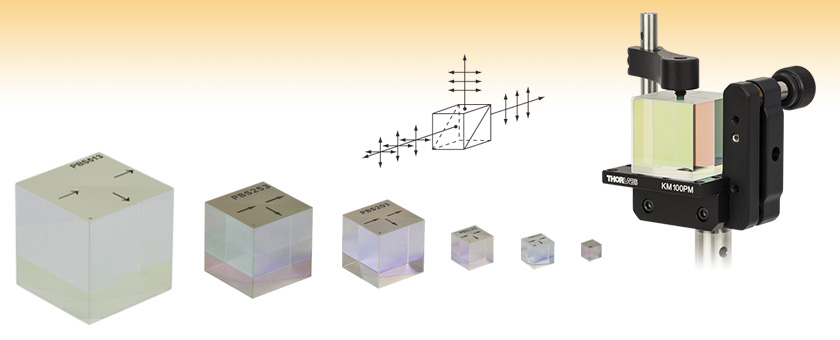
- Available in Sizes Ranging From 5 mm to 2" (50.8 mm)
- Reflects S Polarization by 90°
- Five Wavelength Ranges Available
PBS102
(10 mm)
PBS253
(1")
PBS201
(20 mm)
PBS054
(5 mm)
PBS122
(1/2")
1" Beamsplitter Cube Mounted on a KM100P Platform Mount with a PM4 Clamping Arm
PBS513
(2")

Please Wait
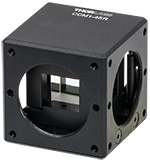
Click to Enlarge
ビームスプリッターアダプタBS127CAMを使って小型ケージキューブCCM1-4ER(/M) に取り付けられた12.7 mmビームスプリッターキューブ。
(「BSキューブの取付け」タブ参照)
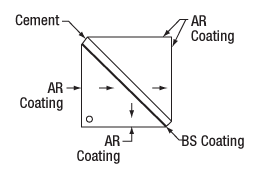
ビームスプリッターキューブの略図
(コーティングと接着層は原寸ではありません)。
特長
- 5 mm、10 mm、12.7 mm(1/2インチ)、20 mm、25.4 mm(1インチ)、50.8 mm(2インチ)キューブ
- 5つの波長範囲をご用意
- 420~680 nm
- 620~1000 nm
- 700~1300 nm
- 900~1300 nm
- 1200~1600 nm
- 消光比
- PBS519:TP:TS > 1000:1(平均)
- TP:TS > 1000:1
当社では、6種類のサイズと5種類の波長域に対応する偏光ビームスプリッターキューブをご用意しています。これらのキューブは、誘電体ビームスプリッターコーティングで、S偏光成分を反射させてP偏光成分を透過することで、S偏光成分とP偏光成分を分離します。こちらのキューブは透過ビームを使用するように設計されており、仕様に定められた波長範囲における消光比は、TP:TS > 1000:1(50.8 mm(2インチ)キューブPBS519のみ、平均値> 1000:1)となっています。ビームスプリッタによりますが、反射光はおよそ20:1~100:1の消光比となります。
偏光ビームスプリッターキューブは、5 mm、10 mm、12.7 mm(1/2インチ)、20 mm、25.4 mm(1インチ)、50.8 mm(2インチ)のサイズをご用意しています。キューブはN-SF1またはH-ZF3ガラス製で、それぞれ420~680 nm、620~1000 nm、700~1300 nm、900~1300 nm、1200~1600 nmの波長範囲をカバーする5種類のコーティングからお選びいただけます。損傷閾値など、キューブの詳細は「仕様」タブを、S偏光成分およびP偏光成分透過率グラフは「グラフ」タブをそれぞれご覧ください。
キューブを形成する2つのプリズムのうちの一方の斜辺に、誘電体ビームスプリッターコーティングを施し、その後、2つのプリズムを接着剤を用いて貼り合わせています(右図参照)。キューブ上面に印字された○印は、ビームスプリッターコーティングされたプリズムの位置を示しています。光はいずれの研磨面からも入射可能で、S偏光、P偏光に分離されます。5 mmよりも大きなサイズのキューブには、光の伝搬方向の推奨光路の1つが矢印で示されています。
マウントのオプションや互換性については「BSキューブの取付け」タブをご参照ください。また、25.4 mm(1インチ)キューブは、ケージキューブに取付け済みでもご提供しております。カスタム仕様のビームスプリッターキューブのご注文に関しましては、当社までお問い合わせください。高出力用途には、ハイパワー偏光ビームスプリッターキューブもご用意しております。また、3000:1 (TP:TS)という高い消光比を持つレーザーライン波長の偏光ビームスプリッターキューブもご用意しています。多面体の広帯域偏光ビームスプリッタは、100 000:1までの高い消光比、高い損傷閾値、低いGDDを兼ね備えています。
| Beamsplitter Cube Size | 5 mm Cube | 10 mm Cube | 1/2" (12.7 mm) Cube | 20 mm Cube | 1" (25.4 mm) Cube | 2" (50.8 mm) Cube |
|---|---|---|---|---|---|---|
| Wavelength Ranges Available | 420 - 680 nm 620 - 1000 nm 700 - 1300 nm 900 - 1300 nm 1200 - 1600 nm | |||||
| Dimensional Tolerance | +0 / -0.2 mm | |||||
| Material | N-SF1 | |||||
| Extinction Ratioa | TP:TS > 1000:1 | PBS519: TP:TS Average > 1000:1 PBS512: TP:TS > 1000:1 PBS515: TP:TS > 1000:1 PBS513: TP:TS > 1000:1 PBS514: TP:TS > 1000:1 | ||||
| Transmission Efficiency | TP > 90% | PBS519: TP, Avg > 85%b PBS512: TP > 90% PBS515: TP > 90% PBS513: TP > 90% PBS514: TP > 90% | ||||
| Reflection Efficiency | RS, Avg > 95% | PBS519: RS, Avg > 93%b PBS512: RS, Avg > 95% PBS515: RS, Avg > 95% PBS513: RS, Avg > 95% PBS514: RS, Avg > 95% | ||||
| Transmitted Beam Deviation | 0° ± 5 arcmin | |||||
| Reflected Beam Deviation | 90° ± 5 arcmin | |||||
| Clear Aperture | > 3.5 mm x 3.5 mm | > 8.0 mm x 8.0 mm | > 10.16 mm x 10.16 mm | > 16.0 mm x 16.0 mm | > 20.32 mm x 20.32 mm | PBS519: > 40.64 mm x 40.64 mm PBS512: > 45.72 mm x 45.72 mm PBS515: > 45.7 mm x 45.7 mm PBS513: > 45.72 mm x 45.72 mm PBS514: > 45.72 mm x 45.72 mm |
| Transmitted Wavefront Error | < λ/4 @ 633 nm (Over Ø3.5 mm) | < λ/4 @ 633 nm (Over Ø8.0 mm) | < λ/4 @ 633 nm (Over Ø10.16 mm) | < λ/4 @ 633 nm (Over Ø16.0 mm) | < λ/4 @ 633 nm (Over Ø20.32 mm) | < λ/2 @ 633 nmc |
| Surface Quality | 40-20 Scratch-Dig | |||||
| Coating Range | AR Coating Reflectancea | Damage Thresholdb | |
|---|---|---|---|
| 420 - 680 nm | Ravg < 0.5% | CWc | 350 W/cm at 532 nm, Ø1.000 mm |
| Pulsed | 2 J/cm2 at 532 nm, 10 ns, 10 Hz | ||
| 620 - 1000 nm | CWc | 50 W/cm at 810 nm, Ø0.019 mm | |
| Pulsed | 2 J/cm2 at 810 nm, 10 ns, 10 Hz | ||
| 700 - 1300 nm | Ravg < 1% | - | |
| 900 - 1300 nm | Ravg < 0.5% | CWc,d | 1000 W/cm at 1070 nm, Ø0.971 mm |
| Pulsed | 2 J/cm2 at 1064 nm, 10 ns, 10 Hz | ||
| 1200 - 1600 nm | CWc,d | 1000 W/cm at 1540 nm, Ø1.030 mm | |
| Pulsed | 5 J/cm2 at 1542 nm, 10 ns, 10 Hz | ||
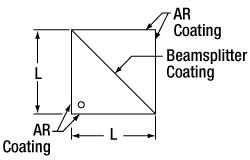
| Coating Range | Damage Thresholda | |
|---|---|---|
| 420 - 680 nm | CWb | 350 W/cm at 532 nm, Ø1.000 mm |
| Pulsed | 2 J/cm2 at 532 nm, 10 ns, 10 Hz | |
| 620 - 1000 nm | CWb | 50 W/cm at 810 nm, Ø0.019 mm |
| Pulsed | 2 J/cm2 at 810 nm, 10 ns, 10 Hz | |
| 900 - 1300 nm | CWb,c | 1000 W/cm at 1070 nm, Ø0.971 mm |
| Pulsed | 2 J/cm2 at 1064 nm, 10 ns, 10 Hz | |
| 1200 - 1600 nm | CWb,c | 1000 W/cm at 1540 nm, Ø1.030 mm |
| Pulsed | 5 J/cm2 at 1542 nm, 10 ns, 10 Hz | |
当社の偏光ビームスプリッターキューブの損傷閾値データ
右の仕様は当社の偏光ビームスプリッターキューブの測定値です。損傷閾値の仕様は波長範囲が同じであればビームスプリッタのサイズにかかわらず同じです。
レーザによる損傷閾値について
このチュートリアルでは、レーザ損傷閾値がどのように測定され、使用する用途に適切な光学素子の決定にその値をどのようにご利用いただけるかを総括しています。お客様のアプリケーションにおいて、光学素子を選択する際、光学素子のレーザによる損傷閾値(Laser Induced Damage Threshold :LIDT)を知ることが重要です。光学素子のLIDTはお客様が使用するレーザの種類に大きく依存します。連続(CW)レーザは、通常、吸収(コーティングまたは基板における)によって発生する熱によって損傷を引き起こします。一方、パルスレーザは熱的損傷が起こる前に、光学素子の格子構造から電子が引き剥がされることによって損傷を受けます。ここで示すガイドラインは、室温で新品の光学素子を前提としています(つまり、スクラッチ&ディグ仕様内、表面の汚染がないなど)。光学素子の表面に塵などの粒子が付くと、低い閾値で損傷を受ける可能性があります。そのため、光学素子の表面をきれいで埃のない状態に保つことをお勧めします。光学素子のクリーニングについては「光学素子クリーニングチュートリアル」をご参照ください。
テスト方法
当社のLIDTテストは、ISO/DIS 11254およびISO 21254に準拠しています。
初めに、低パワー/エネルギのビームを光学素子に入射します。その光学素子の10ヶ所に1回ずつ、設定した時間(CW)またはパルス数(決められたprf)、レーザを照射します。レーザを照射した後、倍率約100倍の顕微鏡を用いた検査で確認し、すべての確認できる損傷を調べます。特定のパワー/エネルギで損傷のあった場所の数を記録します。次に、そのパワー/エネルギを増やすか減らすかして、光学素子にさらに10ヶ所レーザを照射します。このプロセスを損傷が観測されるまで繰返します。損傷閾値は、光学素子が損傷に耐える、損傷が起こらない最大のパワー/エネルギになります。1つのミラーBB1-E02の試験結果は以下のようなヒストグラムになります。
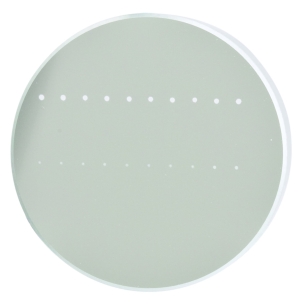
上の写真はアルミニウムをコーティングしたミラーでLIDTテストを終えたものです。このテストは、損傷を受ける前のレーザのエネルギは0.43 J/cm2 (1064 nm、10 ns pulse、 10 Hz、Ø1.000 mm)でした。
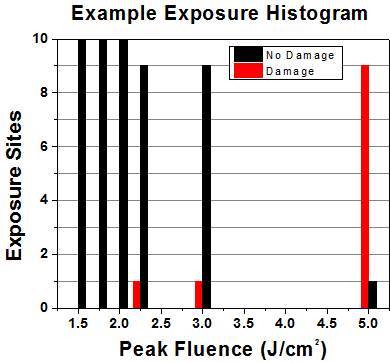
| Example Test Data | |||
|---|---|---|---|
| Fluence | # of Tested Locations | Locations with Damage | Locations Without Damage |
| 1.50 J/cm2 | 10 | 0 | 10 |
| 1.75 J/cm2 | 10 | 0 | 10 |
| 2.00 J/cm2 | 10 | 0 | 10 |
| 2.25 J/cm2 | 10 | 1 | 9 |
| 3.00 J/cm2 | 10 | 1 | 9 |
| 5.00 J/cm2 | 10 | 9 | 1 |
試験結果によれば、ミラーの損傷閾値は 2.00 J/cm2 (532 nm、10 ns pulse、10 Hz、 Ø0.803 mm)でした。尚、汚れや汚染によって光学素子の損傷閾値は大幅に低減されるため、こちらの試験はクリーンな光学素子で行っています。また、特定のロットのコーティングに対してのみ試験を行った結果ではありますが、当社の損傷閾値の仕様は様々な因子を考慮して、実測した値よりも低めに設定されており、全てのコーティングロットに対して適用されています。
CWレーザと長パルスレーザ
光学素子がCWレーザによって損傷を受けるのは、通常バルク材料がレーザのエネルギを吸収することによって引き起こされる溶解、あるいはAR(反射防止)コーティングのダメージによるものです[1]。1 µsを超える長いパルスレーザについてLIDTを論じる時は、CWレーザと同様に扱うことができます。
パルス長が1 nsと1 µs の間のときは、損傷は吸収、もしくは絶縁破壊のどちらかで発生していると考えることができます(CWとパルスのLIDT両方を調べなければなりません)。吸収は光学素子の固有特性によるものか、表面の不均一性によるものかのどちらかによって起こります。従って、LIDTは製造元の仕様以上の表面の質を有する光学素子にのみ有効です。多くの光学素子は、ハイパワーCWレーザで扱うことができる一方、アクロマティック複レンズのような接合レンズやNDフィルタのような高吸収光学素子は低いCWレーザ損傷閾値になる傾向にあります。このような低い損傷閾値は接着剤や金属コーティングにおける吸収や散乱によるものです。

線形パワー密度におけるLIDTに対するパルス長とスポットサイズ。長パルス~CWでは線形パワー密度はスポットサイズにかかわらず一定です。 このグラフの出典は[1]です。
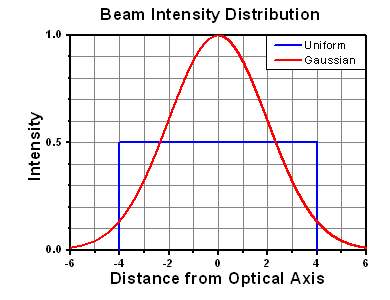
繰返し周波数(prf)の高いパルスレーザは、光学素子に熱的損傷も引き起こします。この場合は吸収や熱拡散率のような因子が深く関係しており、残念ながらprfの高いレーザが熱的影響によって光学素子に損傷を引き起こす場合の信頼性のあるLIDTを求める方法は確立されておりません。prfの大きいビームでは、平均出力およびピークパワーの両方を等しいCW出力と比較する必要があります。また、非常に透過率の高い材料では、prfが上昇してもLIDTの減少は皆無かそれに近くなります。
ある光学素子の固有のCWレーザの損傷閾値を使う場合には、以下のことを知る必要があります。
- レーザの波長
- ビーム径(1/e2)
- ビームのおおよその強度プロファイル(ガウシアン型など)
- レーザのパワー密度(トータルパワーをビームの強度が1/e2の範囲の面積で割ったもの)
ビームのパワー密度はW/cmの単位で計算します。この条件下では、出力密度はスポットサイズとは無関係になります。つまり、スポットサイズの変化に合わせてLIDTを計算し直す必要がありません(右グラフ参照)。平均線形パワー密度は、下の計算式で算出できます。

ここでは、ビーム強度プロファイルは一定であると仮定しています。次に、ビームがホットスポット、または他の不均一な強度プロファイルの場合を考慮して、おおよその最大パワー密度を計算する必要があります。ご参考までに、ガウシアンビームのときはビームの強度が1/e2の2倍のパワー密度を有します(右下図参照)。
次に、光学素子のLIDTの仕様の最大パワー密度を比較しましょう。損傷閾値の測定波長が光学素子に使用する波長と異なっている場合には、その損傷閾値は適宜補正が必要です。おおよその目安として参考にできるのは、損傷閾値は波長に対して比例関係であるということです。短い波長で使う場合、損傷閾値は低下します(つまり、1310 nmで10 W/cmのLIDTならば、655 nmでは5 W/cmと見積もります)。

この目安は一般的な傾向ですが、LIDTと波長の関係を定量的に示すものではありません。例えば、CW用途では、損傷はコーティングや基板の吸収によってより大きく変化し、必ずしも一般的な傾向通りとはなりません。上記の傾向はLIDT値の目安として参考にしていただけますが、LIDTの仕様波長と異なる場合には当社までお問い合わせください。パワー密度が光学素子の補正済みLIDTよりも小さい場合、この光学素子は目的の用途にご使用いただけます。
当社のウェブ上の損傷閾値の仕様と我々が行った実際の実験の値の間にはある程度の差があります。これはロット間の違いによって発生する誤差を許容するためです。ご要求に応じて、当社は個別の情報やテスト結果の証明書を発行することもできます。損傷解析は、類似した光学素子を用いて行います(お客様の光学素子には損傷は与えません)。試験の費用や所要時間などの詳細は、当社までお問い合わせください。
パルスレーザ
先に述べたように、通常、パルスレーザはCWレーザとは異なるタイプの損傷を光学素子に引き起こします。パルスレーザは損傷を与えるほど光学素子を加熱しませんが、光学素子から電子をひきはがします。残念ながら、お客様のレーザに対して光学素子のLIDTの仕様を照らし合わせることは非常に困難です。パルスレーザのパルス幅に起因する光学素子の損傷には、複数の形態があります。以下の表中のハイライトされた列は当社の仕様のLIDT値が当てはまるパルス幅に対する概要です。
パルス幅が10-9 sより短いパルスについては、当社の仕様のLIDT値と比較することは困難です。この超短パルスでは、多光子アバランシェ電離などのさまざまなメカニクスが損傷機構の主流になります[2]。対照的に、パルス幅が10-7 sと10-4 sの間のパルスは絶縁破壊、または熱的影響により光学素子の損傷を引き起こすと考えられます。これは、光学素子がお客様の用途に適しているかどうかを決定するために、レーザービームに対してCWとパルス両方による損傷閾値を参照しなくてはならないということです。
| Pulse Duration | t < 10-9 s | 10-9 < t < 10-7 s | 10-7 < t < 10-4 s | t > 10-4 s |
|---|---|---|---|---|
| Damage Mechanism | Avalanche Ionization | Dielectric Breakdown | Dielectric Breakdown or Thermal | Thermal |
| Relevant Damage Specification | No Comparison (See Above) | Pulsed | Pulsed and CW | CW |
お客様のパルスレーザに対してLIDTを比較する際は、以下のことを確認いただくことが重要です。
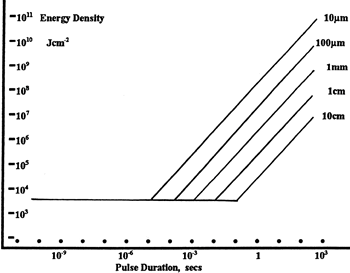
エネルギ密度におけるLIDTに対するパルス長&スポットサイズ。短パルスでは、エネルギ密度はスポットサイズにかかわらず一定です。このグラフの出典は[1]です。
- レーザの波長
- ビームのエネルギ密度(トータルエネルギをビームの強度が1/e2の範囲の面積で割ったもの)
- レーザのパルス幅
- パルスの繰返周波数(prf)
- 実際に使用するビーム径(1/e2 )
- ビームのおおよその強度プロファイル(ガウシアン型など)
ビームのエネルギ密度はJ/cm2の単位で計算します。右のグラフは、短パルス光源には、エネルギ密度が適した測定量であることを示しています。この条件下では、エネルギ密度はスポットサイズとは無関係になります。つまり、スポットサイズの変化に合わせてLIDTを計算し直す必要がありません。ここでは、ビーム強度プロファイルは一定であると仮定しています。ここで、ビームがホットスポット、または他の不均一な強度プロファイルの場合を考慮して、おおよその最大パワー密度を計算する必要があります。ご参考までに、ガウシアンビームのときは一般にビームの強度が1/e2のときの2倍のパワー密度を有します。
次に、光学素子のLIDTの仕様と最大エネルギ密度を比較しましょう。損傷閾値の測定波長が光学素子に使用する波長と異なっている場合には、その損傷閾値は適宜補正が必要です[3]。経験則から、損傷閾値は波長に対して以下のような平方根の関係であるということです。短い波長で使う場合、損傷閾値は低下します(例えば、1064 nmで 1 J/cm2のLIDTならば、532 nmでは0.7 J/cm2と計算されます)。

波長を補正したエネルギ密度を得ました。これを以下のステップで使用します。
ビーム径は損傷閾値を比較する時にも重要です。LIDTがJ/cm2の単位で表される場合、スポットサイズとは無関係になりますが、ビームサイズが大きい場合、LIDTの不一致を引き起こす原因でもある不具合が、より明らかになる傾向があります[4]。ここで示されているデータでは、LIDTの測定には<1 mmのビーム径が用いられています。ビーム径が5 mmよりも大きい場合、前述のようにビームのサイズが大きいほど不具合の影響が大きくなるため、LIDT (J/cm2)はビーム径とは無関係にはなりません。
次に、パルス幅について補正します。パルス幅が長くなるほど、より大きなエネルギに光学素子は耐えることができます。パルス幅が1~100 nsの場合の近似式は以下のようになります。

お客様のレーザのパルス幅をもとに、光学素子の補正されたLIDTを計算するのにこの計算式を使います。お客様の最大エネルギ密度が、この補正したエネルギ密度よりも小さい場合、その光学素子はお客様の用途でご使用いただけます。ご注意いただきたい点は、10-9 s と10-7 sの間のパルスにのみこの計算が使えることです。パルス幅が10-7 sと10-4 sの間の場合には、CWのLIDTも調べなければなりません。
当社のウェブ上の損傷閾値の仕様と我々が行った実際の実験の値の間にはある程度の差があります。これはロット間の違いによって発生する誤差を許容するためです。ご要求に応じて、当社では個別のテスト情報やテスト結果の証明書を発行することも可能です。詳細は、当社までお問い合わせください。
[1] R. M. Wood, Optics and Laser Tech. 29, 517 (1997).
[2] Roger M. Wood, Laser-Induced Damage of Optical Materials (Institute of Physics Publishing, Philadelphia, PA, 2003).
[3] C. W. Carr et al., Phys. Rev. Lett. 91, 127402 (2003).
[4] N. Bloembergen, Appl. Opt. 12, 661 (1973).
レーザーシステムが光学素子に損傷を引き起こすかどうか判断するプロセスを説明するために、レーザによって引き起こされる損傷閾値(LIDT)の計算例をいくつかご紹介します。同様の計算を実行したい場合には、右のボタンをクリックしてください。計算ができるスプレッドシートをダウンロードいただけます。ご使用の際には光学素子のLIDTの値と、レーザーシステムの関連パラメータを緑の枠内に入力してください。スプレッドシートでCWならびにパルスの線形パワー密度、ならびにパルスのエネルギ密度を計算できます。これらの値はスケーリング則に基づいて、光学素子のLIDTの調整スケール値を計算するのに用いられます。計算式はガウシアンビームのプロファイルを想定しているため、ほかのビーム形状(均一ビームなど)には補正係数を導入する必要があります。 LIDTのスケーリング則は経験則に基づいていますので、確度は保証されません。なお、光学素子やコーティングに吸収があると、スペクトル領域によってLIDTが著しく低くなる場合があります。LIDTはパルス幅が1ナノ秒(ns)未満の超短パルスには有効ではありません。
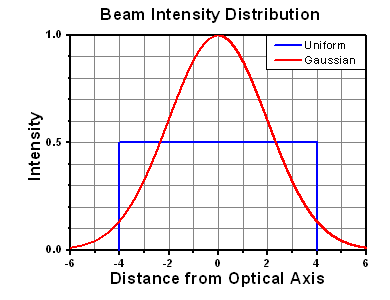
ガウシアンビームの最大強度は均一ビームの約2倍です。
CWレーザの例
波長1319 nm、ビーム径(1/e2)10 mm、パワー0.5 Wのガウシアンビームを生成するCWレーザーシステム想定します。このビームの平均線形パワー密度は、全パワーをビーム径で単純に割ると0.5 W/cmとなります。

しかし、ガウシアンビームの最大パワー密度は均一ビームの約2倍です(右のグラフ参照)。従って、システムのより正確な最大線形パワー密度は1 W/cmとなります。
アクロマティック複レンズAC127-030-CのCW LIDTは、1550 nmでテストされて350 W/cmとされています。CWの損傷閾値は通常レーザ光源の波長に直接スケーリングするため、LIDTの調整値は以下のように求められます。

LIDTの調整値は350 W/cm x (1319 nm / 1550 nm) = 298 W/cmと得られ、計算したレーザーシステムのパワー密度よりも大幅に高いため、この複レンズをこの用途に使用しても安全です。
ナノ秒パルスレーザの例:パルス幅が異なる場合のスケーリング
出力が繰返し周波数10 Hz、波長355 nm、エネルギ1 J、パルス幅2 ns、ビーム径(1/e2)1.9 cmのガウシアンビームであるNd:YAGパルスレーザーシステムを想定します。各パルスの平均エネルギ密度は、パルスエネルギをビームの断面積で割って求めます。

上で説明したように、ガウシアンビームの最大エネルギ密度は平均エネルギ密度の約2倍です。よって、このビームの最大エネルギ密度は約0.7 J/cm2です。
このビームのエネルギ密度を、広帯域誘電体ミラーBB1-E01のLIDT 1 J/cm2、そしてNd:YAGレーザーラインミラーNB1-K08のLIDT 3.5 J/cm2と比較します。LIDTの値は両方とも、波長355 nm、パルス幅10 ns、繰返し周波数10 Hzのレーザで計測しました。従って、より短いパルス幅に対する調整を行う必要があります。 1つ前のタブで説明したようにナノ秒パルスシステムのLIDTは、パルス幅の平方根にスケーリングします:

この調整係数により広帯域誘電体ミラーBB1-E01のLIDTは0.45 J/cm2に、Nd:YAGレーザーラインミラーのLIDTは1.6 J/cm2になり、これらをビームの最大エネルギ密度0.7 J/cm2と比較します。広帯域ミラーはレーザによって損傷を受ける可能性があり、より特化されたレーザーラインミラーがこのシステムには適していることが分かります。
ナノ秒パルスレーザの例:波長が異なる場合のスケーリング
波長1064 nm、繰返し周波数2.5 Hz、パルスエネルギ100 mJ、パルス幅10 ns、ビーム径(1/e2)16 mmのレーザ光を、NDフィルタで減衰させるようなパルスレーザーシステムを想定します。これらの数値からガウシアン出力における最大エネルギ密度は0.1 J/cm2になります。Ø25 mm、OD 1.0の反射型NDフィルタ NDUV10Aの損傷閾値は355 nm、10 nsのパルスにおいて0.05 J/cm2で、同様の吸収型フィルタ NE10Aの損傷閾値は532 nm、10 nsのパルスにおいて10 J/cm2です。1つ前のタブで説明したように光学素子のLIDTは、ナノ秒パルス領域では波長の平方根にスケーリングします。

スケーリングによりLIDTの調整値は反射型フィルタでは0.08 J/cm2、吸収型フィルタでは14 J/cm2となります。このケースでは吸収型フィルタが光学損傷を防ぐには適した選択肢となります。
マイクロ秒パルスレーザの例
パルス幅1 µs、パルスエネルギ150 µJ、繰返し周波数50 kHzで、結果的にデューティーサイクルが5%になるレーザーシステムについて考えてみます。このシステムはCWとパルスレーザの間の領域にあり、どちらのメカニズムでも光学素子に損傷を招く可能性があります。レーザーシステムの安全な動作のためにはCWとパルス両方のLIDTをレーザーシステムの特性と比較する必要があります。
この比較的長いパルス幅のレーザが、波長980 nm、ビーム径(1/e2)12.7 mmのガウシアンビームであった場合、線形パワー密度は5.9 W/cm、1パルスのエネルギ密度は1.2 x 10-4 J/cm2となります。これをポリマーゼロオーダ1/4波長板WPQ10E-980のLIDTと比較してみます。CW放射に対するLIDTは810 nmで5 W/cm、10 nsパルスのLIDTは810 nmで5 J/cm2です。前述同様、光学素子のCW LIDTはレーザ波長と線形にスケーリングするので、CWの調整値は980 nmで6 W/cmとなります。一方でパルスのLIDTはレーザ波長の平方根とパルス幅の平方根にスケーリングしますので、1 µsパルスの980 nmでの調整値は55 J/cm2です。光学素子のパルスのLIDTはパルスレーザのエネルギ密度よりはるかに大きいので、個々のパルスが波長板を損傷することはありません。しかしレーザの平均線形パワー密度が大きいため、高出力CWビームのように光学素子に熱的損傷を引き起こす可能性があります。
当社のビームスプリッターキューブ用に、様々なマウントをご提供しています。下記のマウントを使用してキューブをポストに取り付けたり、16 mmまたは30 mmケージシステムに組み込んだりすることができます。ポスト取付け用のマウントは、M4タップ穴付きØ12 mm~Ø12.7 mm(Ø1/2インチ)ポストまたはØ25 mm~Ø25.4 mm(Ø1インチ)ポストに取り付け可能です。
| Post-Mountable Mounts for Beamsplitter Cubes | ||||||||
|---|---|---|---|---|---|---|---|---|
| Click Photo to Enlarge (Cubes Not Included) | 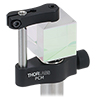 | 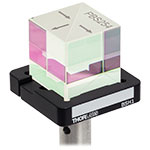 | 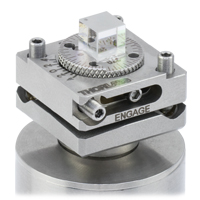 | 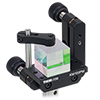 | 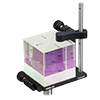 | 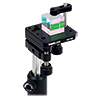 | 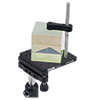 | 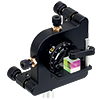 |
| Item # | PCM(/M) | BSH10(/M) BSH05(/M) BSH20(/M) BSH1(/M) BSH2(/M) | FBTB(/M) | KM100PM(/M) | KM200PM(/M) | KM100B(/M) | KM200B(/M) | K6XS |
| Required Accessories | Base: PCMP(/M) | - | - | Clamp: PM3(/M) or PM4(/M) | Clamp: PM3(/M) or PM4(/M) | Clamp: PM3(/M) or PM4(/M) | Clamp: PM3(/M) or PM4(/M) | Adapter: K6A1(/M) |
| Mounting Options | Ø1/2" Posts | Ø1/2" Postsa,b | Ø1/2" Posts | Ø1/2" Posts | Ø1/2" Posts | Ø1/2" Posts | Ø1/2" Posts | Ø1/2" Posts |
| Features | Compact | Compact | Glue-In Mount with Precision Tip, Tilt, and Rotation | Tip and Rotation | Tip and Rotation | Kinematic Mount | Kinematic Mount | 6-Axis Mount |
| Compatible Beamsplitter Cube Size(s) | Up to 20 mm | 10 mm, 1/2", 20 mm, 1", 2" | 5 mm | Up to 20 mmc Up to 1" d | Up to 20 mmc Up to 1" d Up to 2" e | Up to 20 mmc Up to 1" d | Up to 20 mmc Up to 1" d Up to 2" e | 5 mm 10 mm 1/2" |
| Cage System Mounts for Beamsplitter Cubes | |||||||||
|---|---|---|---|---|---|---|---|---|---|
| Click Photo to Enlarge (Cubes Not Included) | 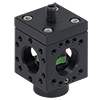 |  | 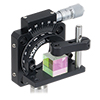 | 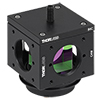 | 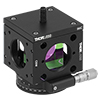 | 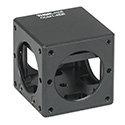 | 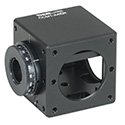 |  | 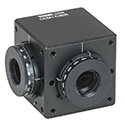 |
| Item # | Cage Cube: SC6W | ARV1 | CRM1(/M) or CRM1P(/M) | Cage Cube: C4W or C6W a | CCM1-4ER(/M) | CCM1-A4ER(/M) | CCM1-B4ER(/M) | CCM1-C4ER(/M) | |
| Required Accessories | Clamp: SB6C, Platform: SPM2 | - | Adapter: K6A1(/M) | Clamp: B6C, Platform: B3C(/M) or B4C(/M) | Clamp: B6C, Platform: B3CR(/M) or B4CRP(/M) | - | - | - | - |
| Mounting Options | 16 mm Cage Systems | 30 mm Cage Systems | 30 mm Cage Systems or Ø1/2" Posts | 30 mm Cage Systems | 30 mm Cage Systems or Ø1/2" Posts | ||||
| Features | Compact | Compact | Rotation Mount | Fixed or Kinematic Platforms | Rotation Platforms | - | One Rotation Mount | Two Rotation Mounts @ 180° | Two Rotation Mounts @ 90° |
| Compatible Beamsplitter Cube Size(s) | 10 mm | 5 mm 10 mm | 5 mm 10 mm 1/2" | 1/2" 20 mm 1" | 5 mm (with BS5CAM Adapter) 10 mm (with BS10CAM Adapter) 1/2" (with BS127CAM Adapter) 20 mm (with BS20CAM Adapter) 1" (Directly Compatible) | ||||
ビームスプリッタのセレクションガイド
当社ではビームを強度比や偏光に基づいて分岐する、様々なタイプのビームスプリッタを豊富に取り揃えています。プレート型やキューブ型のビームスプリッタのほか、形状の異なるペリクルや複屈折性結晶を用いた製品もございます。それぞれの概要や特徴・用途の比較についてはこちらの概要タブをご覧ください。ビームスプリッタの多くはマウント付きまたはマウント無しでご提供しています。以下では、当社のビームスプリッタの全製品を一覧できます。各種類のMore [+]をクリックすると、ビームスプリッタの種類、波長域、分岐比/消光比、透過率、サイズなどの詳細をご覧いただけます。
プレート型ビームスプリッタ
| 偏光無依存ビームスプリッタ、プレート型 |
|---|
| 偏光ビームスプリッタ、プレート型 |
|---|
キューブ型ビームスプリッタ
| 偏光無依存ビームスプリッタ、キューブ型 |
|---|
| 偏光キューブおよび多面体ビームスプリッタ |
|---|
| Type | Wavelength Range | Extinction Ratio (TP:TS) | Typical Transmission | AR Coated Faces | Cemented | Available Cube/ Polyhedron Side Length |
| Standard: Unmounted 16 mm Cage Cube 30 mm Cage Cube | 420 - 680 nm | >1000:1 | Yes | Yes | Unmounted: 5 mm, 10 mm, 1/2", 20 mm, 1", and 2" Mounted: 20 mm in a 16 mm Cage Cube, 1" in a 30 mm Cage Cube | |
| 620 - 1000 nm | ||||||
| 700 - 1300 nm | ||||||
| 900 - 1300 nm | ||||||
| 1200 - 1600 nm | ||||||
| Wire Grid: Unmounted 30 mm Cage Cube | 400 - 700 nm | >1000:1 (AOI: 0° - 5°) >100:1 (AOI: 0° - 25°) | P-Pol. S-Pol. | Yes | Yes | Unmounted: 1" Mounted: 20 mm in a 16 mm Cage Cube, 1" in a 30 mm Cage Cube |
| High-Power Laser Line: Unmounted 30 mm Cage Cube | 355 nm | >2000:1 | No | Unmounted: 1/2" and 1" Mounted: 1" in a 30 mm Cage Cube | ||
| 405 nm | ||||||
| 532 nm | ||||||
| 633 nm | ||||||
| 780 - 808 nm | ||||||
| 1064 nm | ||||||
| Laser Line: Unmounted 30 mm Cage Cube | 532 nm | >3000:1 | Yes | Yes | Unmounted: 10 mm, 1/2", and 1" Mounted: 1" in a 30 mm Cage Cube | |
| 633 nm | ||||||
| 780 nm | ||||||
| 980 nm | ||||||
| 1064 nm | ||||||
| 1550 nm | ||||||
| High-Power, Broadband, High Extinction Ratio Polarizers | 700 - 1100 nm | >1000:1 (700 - 1100 nm) >5000:1 (750 - 1000 nm) >10 000:1 (800 - 900 nm) | Yes | No | 12.7 mm (Input/Output Face, Square) | |
| 900 - 1300 nm | >1000:1 (900 - 1300 nm) >10 000:1 (900 - 1250 nm) >100 000:1 (980 - 1080 nm) | 10.0 mm and 5.0 mm (Input/Output Face, Square) | ||||
| Laser-Line Variable | 532 nm | Not Specified | No Graph Available | Yes | Yes | Assembly Mounted in a 30 mm Cage Cube |
| 633 nm | ||||||
| 780 nm | ||||||
| 1064 nm | ||||||
| 1550 nm | ||||||
| Broadband Variable | 420 - 680 nm | Not Specified | No Graph Available | Yes | Yes | Assembly Mounted in a 30 mm Cage Cube |
| 690 - 1000 nm | ||||||
| 900 - 1200 nm | ||||||
| 1200 - 1600 nm | ||||||
| Circular Polarizer/Beamsplitter | 532 nm | Not Specified | No Graph Available | Yes | Yes | Assembly Mounted in a 30 mm Cage Cube |
| 633 nm | ||||||
| 780 nm | ||||||
| 1064 nm | ||||||
| 1550 nm |
ペリクルビームスプリッタ
| 偏光無依存ビームスプリッタ、ペリクル型 |
|---|
結晶ビームスプリッタ
| 偏光ビームスプリッタ、結晶型 |
|---|
その他
| その他のビームスプリッタ |
|---|
偏光子セレクションガイド
当社では、ワイヤーグリッド、フィルム、方解石、α-BBO、ルチル、ならびにビームスプリッタを含むさまざまな偏光子をご用意しております。 ワイヤーグリッド偏光子のラインナップは、可視域から遠赤外域にも達する波長範囲に対応します。 ナノ粒子直線フィルム偏光子は最高で100 000:1の消光比を有しています。 また、その他のフィルム偏光子は、可視域から近赤外域までの光の偏光に使用できる製品としてお手軽な価格でご提供しております。 次に当社のビームスプリッタ偏光子は反射ビームの利用や、より完全に偏光された透過ビームの使用を可能にします。 最後に、α-BBO(UV域)、方解石(可視~近赤外域)、ルチル(近赤外~中赤外域)ならびに、オルトバナジン酸イットリウム(YVO4)(近赤外域~中赤外域)偏光子は、それぞれの波長範囲で100 000:1の高い 消光比を有する製品となっております。
偏光子の種類、波長範囲、消光比、透過率、ならびにサイズについては、下の表のMore [+]をクリックしてご覧ください。
| Wire Grid Polarizers |
|---|
| Film Polarizers |
|---|
| Beamsplitting Polarizers |
|---|
| Polarizer Type | Wavelength Range | Extinction Ratio | Transmissiona | Available Sizes |
| Polarizing Plate Beamsplitters | 405 nm | >10 000:1 | Ø1" and 25 mm x 36 mm | |
| 532 nm | ||||
| 633 nm | ||||
| 780 nm | ||||
| 808 nm | ||||
| 1030 nm | ||||
| 1064 nm | ||||
| 1310 nm | ||||
| 1550 nm | ||||
| Polarizing Bandpass Filters | 355 nm +6 nm / -9 nm | 1 000 000:1 | 25.2 mm x 35.6 mm | |
| Broadband Polarizing Beamsplitter Cubes (Unmounted, 16 mm Cage Cube, or 30 mm Cage Cube) | 420 nm - 680 nm | 1000:1e | 5 mm, 10 mm, 1/2", 20 mmf, 1"f, and 2" | |
| 620 nm - 1000 nm | ||||
| 700 nm - 1300 nm | ||||
| 900 nm - 1300 nm | ||||
| 1200 nm - 1600 nm | ||||
| Wire Grid Polarizing Beamsplitter Cubes (Unmounted or 30 mm Cage Cube) | 400 nm - 700 nm | >1 000:1 (AOI: 0° - 5°) >100:1 (AOI: 0° - 25°) | P-Pol. S-Pol. | 1"f |
| Laser-Line Polarizing Beamsplitter Cubes (Unmounted or 30 mm Cage Cube) | 532 nm | 3000:1 | 10 mm, 1/2", 1"f | |
| 633 nm | ||||
| 780 nm | ||||
| 980 nm | 1"f | |||
| 1064 nm | 10 mm, 1/2", 1"f | |||
| 1550 nm | ||||
| High-Power Laser-Line Polarizing Beamsplitter Cubes (Unmounted or 30 mm Cage Cube) | 355 nm | 2000:1 | 1/2" and 1"f | |
| 405 nm | ||||
| 532 nm | ||||
| 633 nm | ||||
| 780 - 808 nm | ||||
| 1064 nm | ||||
| High-Power, Broadband, High Extinction Ratio Polarizers | 700 nm - 1100 nm | > 1000:1 (700 - 1100 nm) > 5000:1 (750 - 1000 nm) > 10 000:1 (800 - 900 nm) | 12.7 mm (Input/Output Face, Square) | |
| 900 nm - 1300 nm | >1000:1 (900 - 1300 nm) >10 000:1 (900 - 1250 nm) >100 000:1 (980 - 1080 nm) | 10 mm and 5 mm (Input/Output Face, Square) | ||
| Calcite Beam Displacers | 350 nmg - 2.3 µm (Uncoated) | - | 10 mmb (Clear Aperture, Square) | |
| Yttrium Orthovanadate (YVO4) Beam Displacers | 488 nm - 3.4 µm (Uncoated) | - | >3 mm x 5 mm Ellipseh (Clear Aperture) | |
| 2000 nm (V Coated) |
| alpha-BBO Polarizers |
|---|
| Calcite Polarizers |
|---|
| Quartz Polarizers |
|---|
| Magnesium Fluoride Polarizers |
|---|
| Yttrium Orthovanadate (YVO4) Polarizers |
|---|
| Rutile Polarizers |
|---|
Insights:偏光の識別ラベルについて
こちらのページでは下記について説明しています。
- 垂直成分と平行成分の識別に使用されるラベルについて
こちらから実験室での実習時のヒントや機器セットアップ時の注意点がご覧いただけます。
垂直成分と平行成分の識別に使用されるラベルについて
偏光が面に対して入射されるときには、よく垂直成分と平行成分で説明されます。これらの成分は互いに、そして光の伝搬方向に対して直交します(図1)。
垂直成分と平行成分に用いられるラベルや記号は、どちらがどちらだか分からなくなる場合があります。表では垂直成分と平行成分に使用されているラベルの一覧がご覧いただけます。
| Labels | Notes | |
|---|---|---|
| Perpendicular | Parallel | |
| s | p | Senkrecht (s) is 'perpendicular' in German. Parallel begins with 'p.' |
| TE | TM | TE: Transverse electric field. |
| ⊥ | // | ⊥ and // are symbols for perpendicular and parallel, respectively. |
| σ | π | The Greek letters corresponding to s and p are σ and π, respectively. |
| Sagittal | Tangential | A sagittal plane is a longitudinal plane that divides a body. |
垂直ならびに平行方向は入射面を基準にして定義されています。図1の動画ではビームが表面から反射されている図で説明しています。入射面は、入射光と反射光の両方を含む面として定義されます。垂直方向は入射面に対して垂直、平行方向は入射面内に平行です。
垂直成分ならびに平行成分の電界は互いに直交する面で振動します。垂直成分の電界は入射面に対して垂直な面で、平行成分の電界は入射面内に平行な面で振動します。偏光は垂直成分と平行成分のベクトルの和です。
垂直入射光
垂直入射光の場合、入射面が定義できないため、このアプローチから光の垂直成分と平行成分を明確に定義することはできません。垂直入射光においてこれらを区別する必要性は限られています。なぜなら垂直入射光のすべての成分の反射率は同じだからです。
最終更新日:2020年3月5日
| Posted Comments: | |
user
(posted 2023-09-17 22:45:40.243) Dear Thorlabs,
We discovered what might seem to be a discrepancy with regards to transmission of PBS 251 at 405 nm. Raw data specified on your website suggests the T should exceed ~88%.
Could you look into it? We would also like to receive the transmission and reflection vs. AOI dependency for different polarizations.
Thank you.
Best regards,
Ian cdolbashian
(posted 2023-09-25 09:41:55.0) Thank you for contacting Thorlabs! The wavelength range available of PBS251 is 420-680nm, the raw data shown on website is typical and the transmission performance outside the coating area will vary from lot to lot, so the transmission difference at 405nm is normal. We have some data for different AOI and will send it to you via email. user
(posted 2023-08-22 17:41:36.28) Hello, can you share the zemax file or membrane file of PBS203? cdolbashian
(posted 2023-08-30 09:56:08.0) Thank you for reaching out to us with this inquiry. Unfortunately, we do not have a Zemax file to share with you. I have contacted you directly to discuss your application. Perhaps there is something alternative which we can share. Clemens Alt
(posted 2023-03-22 11:27:25.38) Hi Thorlabs team,
It's a bit surprising that only the large (1") polarizing beam splinters are available with 700-1300 nm coating. It would be very useful if the small ones (1/2" and smaller) were also made available with that coating.
The tuning range of femtosecond lasers is increasing. E.g. I am looking to combine a fixed 1045 nm beam with a beam that is tunable from 680 -1300. A large beam splitter cube just adds an unnecessary length of glass.
All the best! cdolbashian
(posted 2023-04-04 11:14:45.0) Thank you for contacting Thorlabs! We can provide the 1/2'' or smaller beam splitter with 700-1300nm coating as a special one. I'll reach out to you directly to discuss your application. Petr Bouchal
(posted 2022-06-15 13:35:28.833) Hello Thorlabs, I am interested in the extinction ratio of broadband polarizing cubes at wavelength 425 nm, or any advice on which of your polarizers performs best at this wavelength. Thanks, Petr cdolbashian
(posted 2022-06-17 04:51:40.0) Thank you for reaching out to us Petr. The extinction ratio you can expect for these cubes, within the operating range specified, will be ~1000:1. This is specified in the specs tab above, and you can see the graphical representation of the transmission and reflected percentages in the Graphs tab, as well as the raw data (link located in each caption). I have reached out to you directly to discuss the various catalogue options we have for polarizing optics. Ha Chang Kyun
(posted 2022-01-26 02:27:58.413) Hello thorlabs. Can you send me input beam angle dependency of polarizing beam spliter transmission/reflection ? jgreschler
(posted 2022-01-27 12:46:18.0) Thank you for reaching out to Thorlabs. You can request additional data on our products by contacting our Tech Support team at techsupport@thorlabs.com. I have reached out directly to provide the AOI data requested. Zhan Tianpeng
(posted 2021-12-14 16:10:55.003) 可以看看关于PBS251的波长在400-900nm之内的曲线吗?关于它的R和T曲线 YLohia
(posted 2021-12-14 01:28:08.0) Hello, thank you for contacting Thorlabs. An applications engineer from our team in China (techsupport-cn@thorlabs.com) will discuss this directly with you. Eric Copenhaver
(posted 2021-08-04 14:59:45.973) There is a spec for the Polarization Extinction Ratio on the transmitted port, i.e. Tp/Ts ~ 30 dB. There is a reflection efficiency for s polarization, Rs, but it would also be very helpful to know what to expect as the PER on the reflected beam (even if the recommendation is to only use the transmitted beam for high PER). Even just a typical number would be good to know. From experience it seems close to ~20:1, 13 dB. YLohia
(posted 2021-08-05 01:22:05.0) Thank you for contacting Thorlabs. Unfortunately, we do not have a specification on the extinction ratio of reflected beam at the moment. The typical value of PER on the reflected beam depends on product type. If you are interested in a specific part number, our Solutions Team (techsales@thorlabs.com) can look into arranging a tested special for a measured reflected PER upon request at an added cost. BANG-YU HSU
(posted 2020-04-21 13:42:59.773) Is it possible to purchase this broadband PBS cube working from 400 nm to 1100 nm like your AB-coating? You currently only have two separated ranges, 420-680 and 620-1000 nm . YLohia
(posted 2020-04-22 08:21:44.0) Thank you for contacting Thorlabs. Custom optics can be requested by emailing techsupport@thorlabs.com. I have reached out to you directly to discuss the possibility of offering this. Chris Pinyan
(posted 2019-12-31 11:15:32.757) can we have log graphs for he S curve so we can see extinction ratio? nbayconich
(posted 2020-01-16 10:50:18.0) Thank you for your feedback. I have forwarded your suggestion to our marketing team. A log scale plot similar to our nanoparticle polarizer transmission & E.R. plots would be much easier to observe the extinction ratio of each beamsmplitter. In the meantime the raw data provided on our webpage can be used to make a log scale plot. Sebastian Fava
(posted 2019-11-29 15:11:26.923) From what I see, you only have coatings which are reflecting s-polirized light and the transmitting p-polirized.
In our setup, we combine two beams with different polirizations (around 1.5 um, 100 fs pulses, 100 kHz repetition rate), and to do so we need to reflect the p-polirized coming from the left and transmit the s-porized.
We can rotate the beam with half wave plates, but this reduces the intensity, and if we rotate the cube we reflect the beam in the direction perpendicular to the plane instead.
Do you have cubes with coatings reflecting the p-polirized light instead? Or can you suggest similar products? nbayconich
(posted 2019-12-05 03:09:06.0) Thank you for contacting Thorlabs. At the moment we do not have polarizing beamsplitters designed to reflect the P polarization state. Our quartz waveplates however can achieve close to >99% transmission which would be the simplest alternative to searching for this particular type of polarizing beamsplitter. David R
(posted 2019-09-30 16:54:36.593) Hello. I am interested in knowing the phase that the PBS252 introduces on vertically polarized light, which is reflected on the PBS, relative to the horizontally polarized component, which is transmitted. Have you measured it? If yes, could you provide me with that data? If no, do you know if it is possible to measure it? nbayconich
(posted 2019-10-10 09:17:00.0) Thank you for contacting Thorlabs. Unfortunately we do not have this information at the moment regarding the effective phase shift of a reflected or transmitted beam. The phase change can be measured with an ellipsometer. amihaybazak
(posted 2018-11-26 12:59:37.68) I am interested in below product. Please send me incident angle dependency of the Polarization transmission and reflection. We need upto +/- 25 degree incident angle. PBS251 25.4 mm Polarizing Beamsplitter Cube, 420 - 680 nm YLohia
(posted 2018-11-27 08:32:24.0) Hello, thank you for contacting Thorlabs. I have reached out to you directly with this information. yongqi.shi
(posted 2018-11-16 13:25:46.467) Hey, why there are some line diffracted pattern after the PBS cube when a gaussian beam penetrating through? nbayconich
(posted 2018-11-19 02:13:31.0) Thank you for contacting Thorlabs. Would it be possible to provide more details about your current setup such as operating wavelength, any additional optics used, etc? If there are any backreflections re-entering either face of the beamsplitter this could cause an interference pattern. I will contact you directly to help troubleshoot this problem you are seeing. gennady.s.sarkisov
(posted 2018-10-09 16:21:24.417) What R and T for 532nm and 1064nm for PBS252 ??? YLohia
(posted 2018-10-10 10:44:22.0) Hello, thank you for contacting Thorlabs. Based on some scans we have performed, we expect the following out-of-band performance with these units:
532nm -> R: 68.44% (s-Pol) 0.28% (p-Pol); T: 8.41% (s-Pol) 80.15% (p-Pol)
1064nm -> R: 96.32% (s-Pol) 0.59% (p-Pol); T: 0.32% (s-Pol) 95.81% (p-Pol) Mark.O.Brown
(posted 2018-04-19 20:13:49.47) Hello,
Your page on Glan-Taylor polarizers inlcudes a helpful "field-of-view" discussion & plot. I assume that there's some dependence for these PBSs as well? In which case it would be nice to have this info here.
All the best,
Mark nbayconich
(posted 2018-04-23 09:33:15.0) Thank you for contacting Thorlabs. Yes the transmission and reflectance performance of the PBS cubes will have a dependence on the angle of incident on the beamsplitter coating. I'll reach out to you directly with additional data regarding the performance at various AOI's. ksuwer
(posted 2018-04-12 18:24:13.403) I'm using 780nm LASER and i mistakenly bought PBS253, not buying PBS252. can i use PBS253 with 780nm LASER? can i know the spec of PBS253 at 780nm wavelength? YLohia
(posted 2018-04-16 03:37:05.0) Hello, thank you for contacting Thorlabs. Unfortunately, we don't have a spec for PBS253 at 780nm since this is outside the beamsplitter coating range. The split ratio will not be ideal and the will also be loss in transmission due to the difference in AR coating range. I will reach out to you directly to look into the possibility of a return in exchange for PBS252. fangjian.wang
(posted 2018-03-02 14:29:14.96) Hallo,
could I heat the PBS104 upto 90°C for several minutes? YLohia
(posted 2018-04-03 09:38:11.0) Hello, thank you for contacting Thorlabs. Heating the PBS104 up to 90°C will be fine. Please note that you should not exceed 100°C for any duration of time. eilon.poem
(posted 2018-02-13 03:52:27.707) Dear Thorlabs,
We're interested in a PBS with the same spectral transmission/reflection as the PBS051 (specifically, good performance at both 404 nm and 808 nm), just made of fused silica, as the N-SF1 glass fluoresces quite badly when excited by 404 nm light. Any other glass with suppressed fluorescence (at least 50 fold suppression with respect to N-SF1) would also do.
Would you be able to find us such a product?
Thanks,
Eilon and Xin-Bing YLohia
(posted 2018-03-29 02:05:50.0) Dear Eilon and Xin-Bing, thank you for contacting Thorlabs. We will reach out to you directly regarding the possibility of offering this custom item. If simultaneous use of 404nm and 808nm light is not required, you can look into our "High Power Laser Line Polarizing Beamsplitter Cubes" that can be found on this page: https://www.thorlabs.com/newgrouppage9.cfm?objectgroup_id=6055. These are made of UV Fused Silica. jysohn
(posted 2018-01-23 08:26:57.54) I am interested in below two products.
Please send me incident angle dependency of the Polarization transmission and reflection.
We need upto +/- 15 degree incident angle.
Jin
PBS101 10 mm Polarizing Beamsplitter Cube, 420 - 680 nm
PBS201 20 mm Polarizing Beamsplitter Cube, 420 - 680 nm nbayconich
(posted 2018-01-25 09:57:01.0) Thank you for contacting Thorlabs. I will contact you directly with additional AOI data for the PBS101 & PBS201. cohennc
(posted 2017-08-16 16:26:12.217) can you send me data on the 900-1300
what is the Transmission and reflectibity in 650nm+635nm
thanks
Nissim tfrisch
(posted 2017-08-30 03:01:19.0) Hello, thank you for contacting Thorlabs. Unfortunately, the cubes designed at 900-1300nm will not be suitable around 650nm. The exact transmissions for S and P states will vary from one lot to another. I will reach out to you directly to discuss your application. vksaini
(posted 2017-07-21 11:27:14.56) Dear Sir/Madam
My laser beam is exactly two inch diameter in round shape and i have to use the polariser intra-cavity for that i need Polarising cube beam splitter of size slightly more than (2"). Could you supply the same, if yes at what cost. Do you any have indian agent.
03 Nos is required in 500-600 nm wavelength range with Tp:Ts extintion ratio at least 1000:1 tfrisch
(posted 2017-07-26 01:16:23.0) Hello, thank you for contacting Thorlabs. I will reach out to you directly regarding a quote for these. user
(posted 2017-06-20 09:53:56.503) Hello,
In the product overview section, you write:
"Light can be input into any of the polished faces to separate the s- and p-polarizations. However, for best performance, the light should enter through one of the entrance faces of the coated prism, which are indicated by a dot."
However, it is unclear what is meant by "for best performance". I am sending laser light on two cascaded PBSs. On the first PBS the light is incident on the dotted prism, so the transmitted light is p-polarized with high purity. On the second PBS, the light is incident on the non-dotted prism, and ~10% of the light is reflected, despite the high purity. Is this normal behavior? Can it still be claimed that either facet can be used to separate polarizations?
I am trying to combine two beams of orthogonal polarization into a single beam. In this case it is inevitable that one beam will enter the non-dotted prism. I don't want to lose 10% of the light. Can you recommend a different product?
I am using 1550nm light.
Thank you very much. tfrisch
(posted 2017-06-27 10:19:59.0) Hello, thank you for contacting Thorlabs. There are two different effects happening here. First, the not about optimal performance concerns the manufacturing method. At the beamsplitting interface, there is a beamsplitter coating as well as cement that holds the two halves together. They are designed such that the light should be reflected off of the coating before passing through the cement, but this is negligible in most applications. As for the 10% reflectance, that is normal. The high purity of the transmitted beam is achieved by maximizing the reflectance of the S state. This minimizes the transmission of the S state so that the transmission is almost entirely P- polarized. However, the reflected state has a significant reflectance for the P state (about 10% as you note). Please reach out to TechSupport@Thorlabs.com to further discuss your application and the sources you are looking to combine. john.kirtley
(posted 2017-05-03 18:47:06.983) Hello,
I am wondering if the 420-680 nm cube will also reflect light at 785 nm. The graph shows still relatively decent beam splitting at 785 nm, so while the P polarized light is transmitted, I am wondering if the S-polarized light is reflected at 785nm. Thanks. tfrisch
(posted 2017-05-19 02:07:08.0) Hello, thank you for contacting Thorlabs. As seen on the Graphs tab, there is a significant transmission bump in the S state in the NIR. Because of this the PER will be greatly reduced. However, absorption would be low, so the non-transmitted component of the S state would be reflected, yes. I will reach out to you directly to discuss your application. kc636
(posted 2016-03-24 09:28:52.423) Do you have a beamsplitter that would work in the 1600-2200nm range?
Alternatively, what is the performance of PBS124 at 1800nm? besembeson
(posted 2016-03-24 02:35:47.0) Response from Bweh at Thorlabs USA: You may want to consider the Glan-Taylor (http://www.thorlabs.us/newgrouppage9.cfm?objectgroup_id=816) or Glan-Laser (http://www.thorlabs.us/newgrouppage9.cfm?objectgroup_id=815) polarizers, whose un-coated versions can be used over a broader spectrum. The polarizing beam splitter coatings generally perform poorly outside the designed spectral range so the PBS124 will not be suitable around 1800nm. joachim.fischer
(posted 2015-01-20 09:47:30.947) Dear Thorlabs team,
do you have (numerical) data for phase vs. wavelength of the reflected beam available? That would be very interesting for me. I'm especially interested in the PBS121.
Joe besembeson
(posted 2015-03-27 10:46:04.0) Response from Bweh at Thorlabs USA: We do not have this data at this time. y.jin
(posted 2014-10-24 14:54:12.527) I would like to ask if I could also use PBS102 as a beam combiner? What about the polarization states of two beams at the output?
Thanks
Yuwei besembeson
(posted 2014-10-30 05:18:07.0) Response from Bweh at Thorlabs USA: Yes you could use this as a beam combiner although we don't have test data yet for this orientation. We expect the polarization states of both beams to stay the same during and after combination. In terms of the expected output power, note that the transmission efficiency of the beamsplitter coating for the p-polarized state is >90% and the reflection efficiency for s-polarized light is >99.5%. dmahler
(posted 2014-04-07 15:07:44.713) What spec (if any) is there for the amount of wedge in the glue used to hold the two prisms together? I am measuring an optical path difference of around 10 microns for two beams entering the beamsplitter about 2mm apart, and am trying to rule out wedge in the beamsplitter.
Thanks, cdaly
(posted 2014-04-09 04:19:18.0) Response from Chris at Thorlabs: We do not have a specification for the wedge angle created by the epoxied surfaced between the prisms. We do however specify a transmitted beam deviated spec to be <5armin. Depending on the deviation along with the incident angle of the beam, this could account for the observed path length difference. leaf
(posted 2014-01-21 09:50:36.73) I am looking for a PBS for both 1064 and 1550 nm wavelengths. Which coating would work better, the 900-1300 nm or the 1200-1600 nm. Spectral plots for both coatings at 1064 and 1550 nm would be very useful. jlow
(posted 2014-01-27 01:56:59.0) Response from Jeremy at Thorlabs: Neither polarizing beamsplitter cube would work at both 1064 and 1550nm. The performance of these beamsplitter cube falls off rapidly outside the specified range. We might have an alternative for you depending on your requirements. I will contact you directly to discuss about your application,. anton.tau
(posted 2014-01-14 15:18:52.86) We bought Polarizing Beamsplitter Cube (PBS054) at Thorlabs 18 Sep 2013 web order acknowledgement WEB N6W421935. Number on the package W006430.
We have installed it into the optical scheme and discovered some strange behavior. The beam that passes through the cube deviates greatly in the plane parallel to the base of the cube. We estimate the deviation to be ~11 degrees, too far from the quoted (<5 arcmin) value. What could be the reason for this?
Best regards,
Anton Tausenev.
Atseva LLC
950 52 ave ct T-4
Greeley, CO, 80634
tel: 970-396-6189
fax: 877-656-6643
www.atseva.com jlow
(posted 2014-01-15 08:23:09.0) Response from Jeremy at Thorlabs: We will contact you directly to troubleshoot this. user
(posted 2013-11-07 19:31:17.093) According to specs tab, PBS can withstand 10,000 W/cm.
It seems quite high damage threshold.
Is it true? tcohen
(posted 2013-11-07 03:53:53.0) Response from Tim at Thorlabs: With a focused spot diameter of 18um, the PBS053 showed no damage with an exposure duration of a minute on 20 separate sites with a power exceeding 10000 W/cm at 1064 nm, Ø0.018 mm. Although we would expect this linear power density to remain constant for an increased beam size, a larger beam is more likely to land on a damage precursor (such as a surface defect), and thus cause damage. ajh
(posted 2013-10-30 17:29:04.08) Could you give a number for the percentage of reflectivity of the AR-coatings at 632nm? In other words, how much ghost reflections does one get at 90degree incidence? tcohen
(posted 2013-11-07 03:43:35.0) Response from Tim at Thorlabs: Each outer optical surface is BBAR coated. The spec within the coating region is Ravg<0.5% at normal angle of incidence. Each surface will have this spec and so you can use this to calculate first back reflection and any ghost reflections after splitting for an approximation of ghost beams. asvaghos.a
(posted 2013-08-09 06:34:11.04) I happened to drop my PBS253 cube to ground. I check it and the beam splitting coating surface doesnt seem to blur or turn intransparent. But however if there is an SOP to check if It still work at least as good as before? jlow
(posted 2013-08-14 14:01:00.0) Response from Jeremy at Thorlabs: We will contact you directly to check the condition of your PBS253. jlow
(posted 2012-08-08 16:50:00.0) Response from Jeremy at Thorlabs: The difference between the beamsplitters for different wavelength ranges are mainly the AR coating and the beamsplitter coating. The performance for out-of-band wavelength cannot be guaranteed. dominic.siriani
(posted 2012-08-08 09:09:50.0) Is the difference between the wavelength ranges on the polarizing beam splitters only the AR coatings on the cube faces? If the 1200-1600 nm splitter were used at ~900 nm, would the transmission extinction ratio still be Tp:Ts > 1000:1? tcohen
(posted 2012-07-03 10:37:00.0) Response from Tim at Thorlabs: Thank you for your inquiry. The design wavelength of the PBS051 is 420nm-680nm. Even with an AR coating of 400nm-700nm, the beamsplitter coating would be out of the specified band. To change the design wavelength would involve creating a custom coating, which would include engineering costs and coating production costs. We offer N-BK7, UVFS, CAF2, ZnSe and Ge right angle prisms. I would like to discuss with you the requirements of your system to provide the best options for your application and I will contact you directly to continue this conversation. joekkrause
(posted 2012-06-28 23:39:17.0) How much would it cost for you to make a custom cube of N-SF1 with an AR coating for the 400-700 nm range? Also do you offer any right angle prisms made of N-SF1? tcohen
(posted 2012-05-16 16:43:00.0) Response from Tim at Thorlabs: Thank you for your feedback! The wavefront distortion is for both the transmitted and reflected beam. We will update our web presentation with this information. ahambi
(posted 2012-05-15 03:51:16.0) Is the wavefront distortion $ \lambda/4 $ also for the reflected beam? tcohen
(posted 2012-03-01 10:54:00.0) Response from Tim at Thorlabs: Thank you for your feedback on the PBS251. It is difficult to produce exact damage thresholds because of the many variables involved. For CW, usually damage occurs first in the substrate. However, surface irregularities in the optic can also play a role. The intensity profile of your beam will also have an influence on a CW LIDT. As an estimate, we advise not using over 13W/cm^2 CW for this product. However, because LIDT decreases with an increase in frequency, the threshold will be lower for your lower wavelength. I have contacted you directly to find out more information on your setup. utsavdeepak.dave
(posted 2012-02-29 09:55:44.0) Hi, I would like to know the damage threshold for the PBS251 product used with blue light (464 nm, CW). bdada
(posted 2011-10-06 20:21:00.0) Response from Buki at Thorlabs:
Thank you for your feedback. What you may be experiencing is the magneto optical Kerr effect - where the polarization of light changes when it interacts with magnetized media. We think the coating and not the material is what is being magnetized and causing the reflected/transmitted beams to be altered. This magnetization will change as the external magnetic field changes, explaining why the unbalance changes at the same frequency as the rotation of the magnetic field.
Please contact TechSupport@thorlabs.com if you want to discuss this further. nmandal
(posted 2011-09-28 15:56:42.0) Should the intensities of the two beams coming out of the PBS change in presence of magnetic field?
I balance the two beams coming out of the PBS and bring a rotating magnetic field closer to the PBS and I see that the beams are not balanced anymore and the unbalance has the same frequency as the magnetic field. I know the PBS contains SF2 which is polar, could this be the cause or something else. jjurado
(posted 2011-06-22 12:50:00.0) Response from Javier at Thorlabs to Mikhail.Levin: Thank you very much for contacting us with your request. We currently do not have information regarding the dependence of the extinction ratio upon the angle of incidence for these polarizing beamsplitters. However, as a guideline, increasing the AOI beyond +/- 2 degrees from the normal of the front surface of the PBS will most likely negatively affect the resultant extinction ratio between the s and p polarizations. I will contact you directly for further support. Mikhail.Levin
(posted 2011-06-21 16:00:08.0) Please inform about the angular sensitivity of your product
Other words:
show the andle( +/- N degrees) in which the extinction parameter (~30dB) is valid Customer Email: Mikhail.Levin@amo.abbott.com This customer would like to be contacted. jjurado
(posted 2011-03-18 11:14:00.0) Response from Javier at Thorlabs to drdougsnyder: Thank you for contacting us with your inquiry. Intrinsic variations in the beamsplitter coating result in different retardance values for both s and p components. For the passing beam (this would be Tp, and Rs), you can expect a retardance on the order of 0.01 waves (worst case), and 0.00 waves in the best case. For the rejected beam (Ts and Rp), the phase change can range from 0.00 to 0.125 waves. jjurado
(posted 2011-03-15 11:55:00.0) Response from Javier at Thorlabs to last poster: Thank you for submitting your inquiry. The refractive index of SF2 at 1064 nm is 1.62758. Please contact us at techsupport@thorlabs.com if you have any further questions. user
(posted 2011-03-15 16:21:10.0) What is the refracted index of SF2 at 1064nm? We inted to tilt the beam splitter a little bit and Id like to compute the lateral displacement of the beam.
Thank you drdougsnyder
(posted 2011-03-09 13:52:35.0) I did not see any information regarding phase change to s and p components due to interaction of light with polarizing beamsplitter cube. You may want to add that information, and I would not mind knowing it. jjurado
(posted 2011-03-03 10:31:00.0) Response from Javier at Thorlabs to Christian Roedel: Thank you for contacting us with your request. Although is is unlikely that the AR coating on the cubes will considerably affect contrast, we can certainly offer these polarizing cubes uncoated. Keep in mind, however, that the cement used to bond the two prisms together limits the damage threshold of the cube to ~2J/cm^2 (810nm, 10Hz PRF, 10ns pulse width). christian.roedel
(posted 2011-03-03 13:34:55.0) Dear Sir or Madam,
we would like to use polarizing beamsplitters in our high intensity laser. For this purpose we need an excellent AR coating in the cube sides to improve our contrast.
I would like to purchase several beamsplitters without the AR coating to see if this has any effect. Would it be possible to buy polarizing beamsplitter cubes without any AR coating?
Thanks in advance
Sincerely,
Christian Rödel jjurado
(posted 2011-02-07 18:01:00.0) Response from Javier at Thorlabs to Tmel630: Thank you very much for contacting us with your request. Our beamsplitters are comprised of two separate prisms. We apply a dielectric coating to the hypotenuse side of one of the two prisms, and then we use cememt to bond the two prisms together. In order to achieve the desired 50:50 split ratio, it is recommended for the light to enter through one of the faces of the coated prism, which is indicated by a dot. We have updated our Overview Tab with this information. Tmel630
(posted 2011-02-04 23:18:42.0) Which face is the input face? Thorlabs
(posted 2010-09-13 16:00:38.0) Response from Javier at Thorlabs to Luis: the recommend maximum energy density for the polarizing beamsplitters coated for 1200-1600 nm (PBS054, PBS104, PBS204, and PBS254) is 5 J/cm^2 (tested at 1542 nm, 10 ns pulse). We currently do not have CW damage threshold information for these cubes. luis.dussan
(posted 2010-09-13 14:15:17.0) what is the damage threshold for the 1550 wavelength for cw and fluence. Thorlabs
(posted 2010-09-10 17:18:24.0) Response from Javier at Thorlabs to Melanie: The wavefront distortion will not vary with size. All of our PBS series beamsplitters have a wavefront distorion spec of < lambda/4 at 633 nm. melanieadams
(posted 2010-09-09 15:11:48.0) I like the idea of mounting the PBS in a cube, but notice you only do these for a 1" PBS cube.
I have a small beam ~ 2 mm across.
How will the wavefront distortion across my beam, vary with the size of the PBS ?
Is it better or worse with a larger PBS ?
thanks,
Melanie vladimirlee
(posted 2010-08-10 15:46:35.0) Does the extinction ratio of the transmitted beam depend on the input polarization? It seems to me that this PBS yields very bad polarization(low extinction ratio) if the input polarization is almost horizontal. user
(posted 2010-08-10 18:23:31.0) Can I cascade two PBSs to get a higher extinction ratio? (>1000:1) user
(posted 2010-06-01 18:57:56.0) Response from Javier at Thorlabs to guille2306: we do not offer any solutions at the moment. However, we are currently evaluating the possibility of expanding the coating into the UV range. I can keep you updated on the progress of this project. Also, we can discuss your application internally in case you have any additional questions. guille2306
(posted 2010-06-01 17:41:27.0) I would be interested in this product, but for the UV range (roughly 230-370nm). Do you have something along this line? jens
(posted 2010-03-29 12:55:39.0) A reply from Jens at Thorlabs to Vladimir: yes, the beamsplitter coating is the reason for the lower extinction ratio of the reflected beam. A dielectric coating is used for these cubes. vladimirlee
(posted 2010-03-28 19:21:25.0) As a follow-up question regarding the extinction ratio: what makes the reflected beam having a lower extinction ratio than the transmitted beam? Is it the beamsplitting coating that makes this difference? And what kind of beamsplitting coating is used in the cubes? Appreciate for your help. Adam
(posted 2010-03-17 18:07:38.0) A response from Adam at Thorlabs to jwoillez: We do have a %T curve and will send this data out to you. Please note that any behaviors outside the designated coating range will vary with every coating run. One run may provide a %T for the P polarization of 65%, while another run may provide a T% for P polarization of 75%. The %T is only optomized for the designated coating range of each product. jwoillez
(posted 2010-03-16 21:36:40.0) What is the behavior of at 600~700 nm of the 900-1300 nm polarizing beamsplitter cube? Practically I would like to combine a 1319 nm p polarization with a red laser (tbd 633, 658, or 690) that would be reflected off the cube. If you had a %T curve for p and s polarizations extending to the visible for the 900-1300 nm, that would help. apalmentieri
(posted 2010-03-11 13:37:28.0) A response from Adam at Thorlabs to vladimirlee: The extinction ratio for the reflected beam is not the same as the transmitted extinction ratio of 1000:1. The reflected beams extinction ratio is 100:1. If you need higher purity polarization, we would suggest using the transmitted beam. vladimirlee
(posted 2010-03-10 16:20:12.0) I wonder whether the extinction ratio is also 1000 to 1 for Ts:Tp for reflected beam? In other words, which beam (reflected or transmitted) do you think should be used for having higher purity polarization? Thanks. apalmentieri
(posted 2010-03-01 17:09:06.0) A response from Adam at Thorlabs: We have not yet sent this optic our for damage threshold testing. We will be sending this optic out in the near future and hope to have more information then. In the meantime, I did not see any contact information. If you could, please send us your information to techsupport@thorlabs.com so we can respond direclty to you when we get the information. The information will also be added to the website, but we would like to ensure you get a proper response. user
(posted 2010-03-01 14:21:58.0) Has the damage threshold data come back yet? If you were to provide this data, I could purchase this product immediately. apalmentieri
(posted 2009-11-20 11:09:53.0) A response from Adam at Thorlabs: The cement used is the epoxy Norland 61. Unfortunately, we do not have damage threshold information for this cement. apalmentieri
(posted 2009-11-20 10:06:37.0) A response from Adam at Thorlabs: Currently, we do not have a specification on how the separation ratio will change with incident angle. Please note we are looking into this. We also do not have an exact fs damage threshold for the beamsplitters, but we do know that the cement is the limiting factor. I am currently looking into the cement material. tiwari.dhir
(posted 2009-11-19 15:32:43.0) Is there any angle of incidence dependence on seperation ratio of polarizations?
I would like to know about power ratings for e.g. for pulsed laser (any standard like 1064 nm @ frequency) and continuous laser. Or what kind of cementing material is used it these polarizing beam splitters. I am interested in using it with 1050 nm Femtosecond laser.
Dhirendra herman
(posted 2009-11-17 21:40:36.0) What is an angular dependence of the polarization ratio?
Thanks, Petr H. jens
(posted 2009-06-11 16:17:00.0) A reply from Jens at Thorlabs: the item has not specifically designed for femtosecond lasers, so I currently do not have for example dispersion data for the product. There is no inherent feature which would prevent using this item with femtosecond lasers. I would suggest to go ahead and test the device in your setup. Certainly we could take the item back if any unforseen effect prevents you from using the item. Dgmoses
(posted 2009-06-11 16:12:02.0) Are there any special issues with this product and use of ultrashort laser pulses. ghegenbart
(posted 2008-12-02 04:02:12.0) Response from Gerald (Tech Support Thorlabs Germany): Thank you very much for your interest in our polarizing beam splitters. The product PBS3 is specifically desigend for application in the telecom wavelength range from about 1525 to 1610 nm. It comes with an AR coating for these wavelengths. Using it for the visible part of the spectrum is not possible. We do not offer other polarizing beam splitters yet, but we will introduce them shortly. The family will consist of products covering 4 different wavelength ranges, one of it being 420 to 680 nm. Sizes range from 5 to 25.4 mm. The products are planned to be released by mid to end of January 2009 and will be featured on our web site as soon as they are available. You may also use our RSS feeds service to get notified when the products are introduced. patrickm
(posted 2008-12-01 14:53:42.0) To what extent is this product designed for 1525-1610nm. Is there an antireflection coating?
I would need a polarizing beam splitter for an application at 532nm - would PBS3 also work at this wavelength? Do you have polarizing beam splitters (with AR coating) specifically designed for visible wave lengths?
Best wishes,
Patrick Maletinsky Laurie
(posted 2008-10-03 09:09:21.0) Response from Laurie at Thorlabs to ADudley: Thank you for your interest in our polarizing beamsplitters. Currently, we cannot provide custom beamsplitters due to the expense of the coating. However, if size is not of primary concern, we are currently in the process of fabricating a 10 mm polarizing beamsplitter for the 400 - 700 nm range.
If you are just looking to split the S and P states of light, you may want to try a glan laser polarizer. These can be found on the following website:
http://www.thorlabs.com/NewGroupPage9.cfm?ObjectGroup_ID=815&pn=GL5-A&CFID=24982801&CFTOKEN=29910522. However, these do not work as well as the PBS3, and you may receive some wavefront errors from the extraordinary ray, as this side does not have a good polish. If we can be of further assistance, please let us know. ADudley
(posted 2008-10-02 03:41:49.0) I am interested in this product, but for the visible wavelength (400-700nm). How do I go about ordering it? And what is an estimated cost for it? As well as delivery time? I am based in South Africa. |

| Item # | PBS051 | PBS052 | PBS055 | PBS053 | PBS054 |
|---|---|---|---|---|---|
| Cube Size | 5 mm x 5 mm x 5 mm | ||||
| Wavelength Range | 420 - 680 nm | 620 - 1000 nm | 700 - 1300 nm | 900 - 1300 nm | 1200 - 1600 nm |
| Material | N-SF1 | ||||
| Transmission | TP > 90% | ||||
| Reflection | RS, Avg > 95% | ||||
| Surface Quality | 40-20 Scratch-Dig | ||||

| Item # | PBS101 | PBS102 | PBS105 | PBS103 | PBS104 |
|---|---|---|---|---|---|
| Cube Size | 10 mm x 10 mm x 10 mm | ||||
| Wavelength Range | 420 - 680 nm | 620 - 1000 nm | 700 - 1300 nm | 900 - 1300 nm | 1200 - 1600 nm |
| Material | N-SF1 | ||||
| Transmission | TP > 90% | ||||
| Reflection | RS, Avg > 95% | ||||
| Surface Quality | 40-20 Scratch-Dig | ||||

| Item # | PBS121 | PBS122 | PBS125 | PBS123 | PBS124 |
|---|---|---|---|---|---|
| Cube Size | 1/2" x 1/2" x 1/2" (12.7 mm x 12.7 mm x 12.7 mm) | ||||
| Wavelength Range | 420 - 680 nm | 620 - 1000 nm | 700 - 1300 nm | 900 - 1300 nm | 1200 - 1600 nm |
| Material | N-SF1 | ||||
| Transmission | TP > 90% | ||||
| Reflection | RS, Avg > 95% | ||||
| Surface Quality | 40-20 Scratch-Dig | ||||

| Item # | PBS201 | PBS202 | PBS205 | PBS203 | PBS204 |
|---|---|---|---|---|---|
| Cube Size | 20 mm x 20 mm x 20 mm | ||||
| Wavelength Range | 420 - 680 nm | 620 - 1000 nm | 700 - 1300 nm | 900 - 1300 nm | 1200 - 1600 nm |
| Material | N-SF1 | ||||
| Transmission | TP > 90% | ||||
| Reflection | RS, Avg > 95% | ||||
| Surface Quality | 40-20 Scratch-Dig | ||||

| Item # | PBS251 | PBS252 | PBS255 | PBS253 | PBS254 |
|---|---|---|---|---|---|
| Cube Size | 1" x 1" x 1" (25.4 mm x 25.4 mm x 25.4 mm) | ||||
| Wavelength Range | 420 - 680 nm | 620 - 1000 nm | 700 - 1300 nm | 900 - 1300 nm | 1200 - 1600 nm |
| Material | N-SF1 | ||||
| Transmission | TP > 90% | ||||
| Reflection | RS, Avg > 95% | ||||
| Surface Quality | 40-20 Scratch-Dig | ||||
 Products Home
Products Home












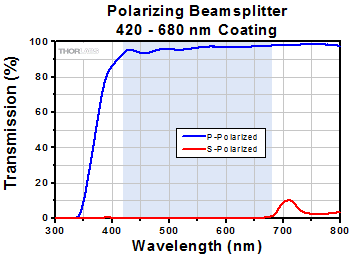
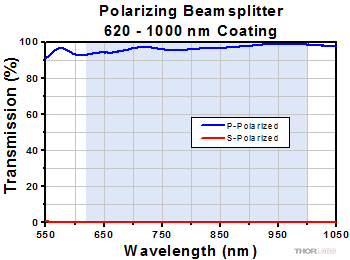
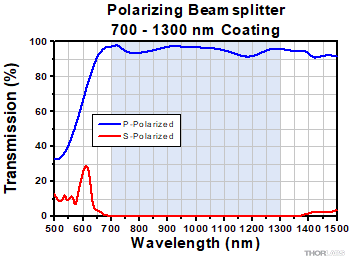
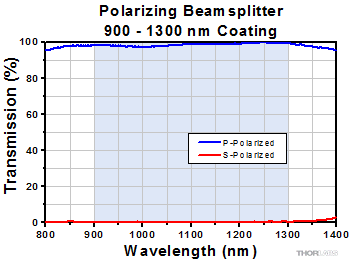
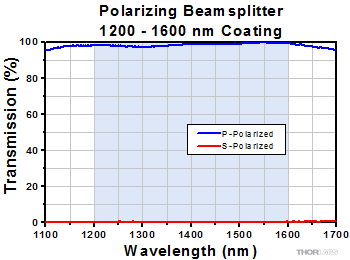



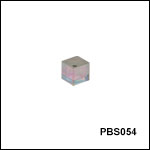
 ズーム
ズーム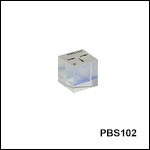
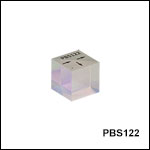
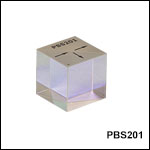

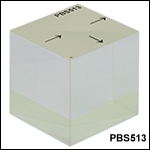
 偏光ビームスプリッターキューブ、マウント無し
偏光ビームスプリッターキューブ、マウント無し